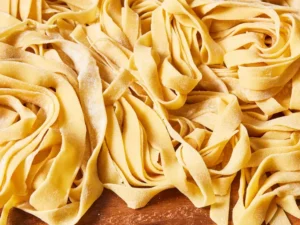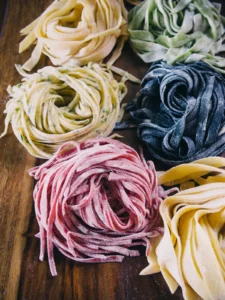We love all kinds of pasta! Not only does it go great with a variety of sauces – we’re talking tomato, creamy, buttery, and vodka variations – but it also pairs with yummy cheeses and savory veggies. Add it to a hearty dish, a simple casserole, or a classic soup recipe. Chef’s kiss.
Now, let’s delve into the intriguing world of pasta. Which is superior – fresh or dry – and what sets them apart? Join us on this culinary journey to discover the answers and explore two of our favorite fresh pasta recipes.
The Ingredients
Dry pasta is made from water, semolina, and egg. Typically, these ingredients are mixed to form a somewhat crumbly dough, which is pressed through an extruder to create fun pasta shapes. From there, the pasta is dried for several days to remove as much moisture from the dough as possible.
On the other hand, fresh pasta is made from eggs and flour (often “00” flour). Depending on the recipe, the chef may add water or olive oil and additional spices. The dough is then needed and passed through a cutting machine. Because this dough is super fresh, it must be cooked and served immediately or stored in the refrigerator for up to a few days.
Serving Size
Understanding serving sizes is key when it comes to pasta. Dry pasta, seemingly modest in a box, undergoes a transformation when cooked, nearly doubling in size. A pound of dry pasta can effortlessly satiate a family of four. However, due to its moisture content, fresh pasta requires a larger portion (about a pound and a half) to serve four people.
Best Served With
Fresh pasta is delicately made, so it makes sense to pair it with a delicate sauce, like Afredo. Dry pasta is a little more fine. Because of this, it goes best with ragu sauces. Soups and casseroles also welcome dry pasta, as its firm structure better holds additional ingredients
Shelf Life
Which type of pasta will last longer in your kitchen pantry? The easy answer: dry pasta. Why? Dry pasta is made in commercial factories at low temperatures. This evaporates the extra moisture, making it possible to store for long periods. Fresh pasta, on the other hand, has a much shorter shelf life. But with that, you get richer flavors.
Pasta Recipes
Two of our favorite homemade pasta recipes are listed below.
Homemade Pasta Dough

(image via all recipes/dotdash meredith food studios)
Many cooks say it’s difficult to make fresh pasta, but not when you have a recipe like this on your hands. Simply gather the five common ingredients and get prepping!
Ingredients:
- 2 cups flour
- 3 large eggs, at room temperature
- 2 Tbsp olive oil
- 1 tsp salt
- 2 Tbsp water
Instructions:
- Mix flour, eggs, olive oil, and salt in a bowl until combined. Add water, 1 tsp at a time, to the mixture until a smooth, thick dough forms.
- Turn dough out onto a lightly floured work surface. Knead for 10 minutes and let 5-10 minutes.
- Divide dough into 8 balls; use a pasta machine to roll and cut dough into desired pasta shape.
Fresh Homemade Herb Pasta Recipe
 (image via garden betty)
(image via garden betty)
If you’re looking to try something new in the pasta game, this herbal recipe from Garden Betty would be a great place to start.
Ingredients:
- 2 cups all-purpose flour
- 3 large eggs
- 2 Tbsp minced fresh herbs (try basil or parsley)
- 2 Tbsp olive oil
Instructions:
- Mound flour onto your work surface and make a large well in the center. You can use a measuring cup to carve out a deep well that’s about 5 inches in diameter.
- Crack eggs into well. Add fresh herbs and olive oil.
- Using a fork, beat the eggs, herbs, and oil until well combined.
- Little by little, add the flour to the egg mixture and beat until all of the ingredients are incorporated. Mix the dough with your fork until it begins to take shape. Gather into a loose ball.
- With your hands, start to knead the dough. It’ll feel soft and jiggly at first, but the dough will become firm after kneading for about 10 minutes.
- Once the dough is smooth and no longer sticky, shape into a ball and cover it with a kitchen towel to prevent it from drying out. Let sit for 30 minutes.
- Cut the dough into quarters.
- On a floured surface, roll the dough as thin as you can. Dust liberally with flour to prevent sticking.
- Lay the pasta sheet on a cutting board and fold the pasta a few times over itself. Then, cut into your desired width.
- Shake the noodles out and toss with flour. Place in pot of boiled salt water and cook 2-5 minutes, depending on thickness.






